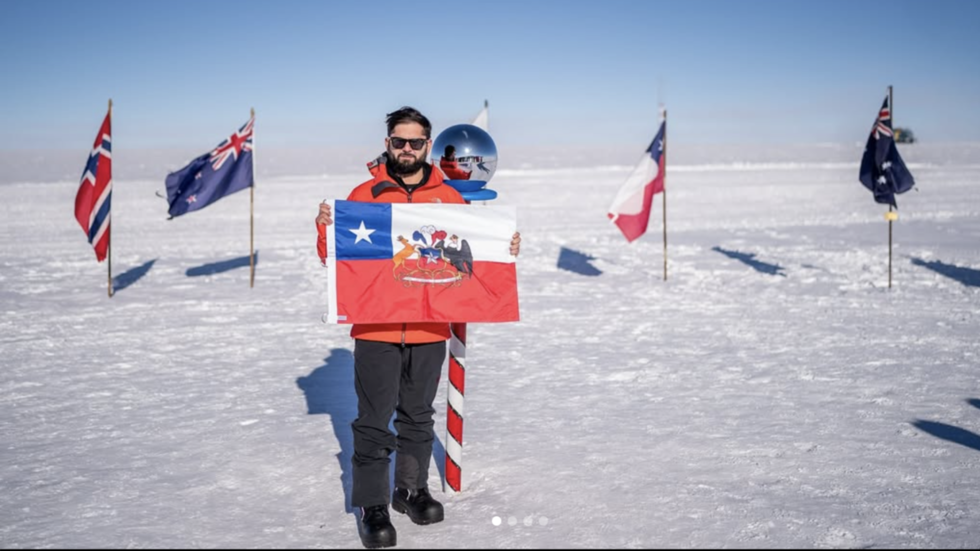
Chile's Boric's trip to the South Pole: geopolitics and conservation
From the South Pole with 'love’? The increasingly chilly geopolitics of Antarctica.
(Feb. 27. 2025). This January 4th, Chilean President Gabriel Boric fulfilled his promise to visit the South Pole for about two hours and under -25 Celsius degrees. It was a promise President Boric had made when he went to Antarctica in November 2023
But Chile’s President did not visit Antarctica alone in 2023. The UN Secretary-General Antonio Guterres traveled with him. Photos of Guterres and Boric's trip to Antarctica, standing on the White Continent, were released worldwide in 2023. Pictures revealed the impressive background of ice retreat due to climate-change-induced insecurities affecting Antarctica and its iconic penguins dying from an outbreak of avian flu circulating from the core to the end of the world. It was on that first trip to the White Continent that Boric promised to return, but beyond Antarctic limits, to the South Pole.
Boric’s visit was meant to make a history of Chile’s presence in Antarctica's outer limits. As one of the original signatories in the Antarctic Treaty (AT) dating back from 1961, when it entered into force, Chile’s 'frozen' claim to Antarctica overlaps the ones made by the United Kingdom and Argentina, but scientific cooperation on the White Continent- despite overlapping claims - is one of the utmost significant gains for peace and science brokered under the various agreements associated with the ATS (Antarctic Treaty System) such as CCAMLR (Convention on the preservation of marine living resources). With this visit, Boric became the first Latin American leader to reach the South Pole 'by foot,' but Boric was not the first Chilean President to visit the White Continent. In 1948, ex-President Gabriel Gonzalez Videla traveled to Antarctica’s Chilean base, 'Sovereignty' (now called 'Arturo Prat'), to reinforce Chile’s claim into the Antarctic Continent, just before the signing of the AT in 1959.
Boric traveled to the Chilean base on Jan 2nd, 2025, on a 2-day trip under Operation Polar Star III to visit the Amundsen-Scott South Pole Station and Chile’s research center operating there. Boric traveled accompanied by government officials, scientists, the press, and TV. The Chilean Air Force undertook the trip, and the pilot in charge of transporting the President and his crew to the Antarctic land was Chile's first woman pilot to fly to the South Pole. Chile’s Boric made the trip using Chilean means and resources.
Why does this trip matter?
Boric’s visit to the South Pole is a statement to world leaders to draw attention to Antarctica as a hotspot dedicated to Nature Conservation, highlighting the ATS’s success in preserving it for peace. While the geopolitics of resource competition gets traction, and narratives increase on mineral extraction from the seabed in Artic waters or rare minerals extraction in the North Pole, Boric’s call to the ATS member states and world leaders, in general is to highlight the more significant dangers looming on Earth, our species and the role of ice in the Planet. Intense competition for rare mineral extraction could not be more antagonistic to the goals pursued by the ATS. This ‘status quo’ in freezing territorial claims on Antarctica provides the platform from which scientists working under the ATS umbrella can supply reliable data on global warming affecting the Southern and Sub-Antarctic Seas’ capacity to cool the atmosphere (CO2 sequestration), essential for our survival, aggravated by human-induced stressors such as microplastic pollution, biodiversity loss and overfishing of the krill.
Thus, Boric’s visit to the South Pole is a strategic move in conservation politics or a performative speech act to reaffirm Chile’s commitment to peace and science, as his address to the Chilean population was televised live, right from the South Pole, standing next to the Chilean flag, aligned with the rest of the original AT signatories’s flags. 'Our focus is on sustainable research and understanding climate change's global impact”, emphasized Boric on live TV. Boric's trip underscores the increasing presence of China in Antarctica at a time of global power competition (GPC); the PRC's ambitions in the Continent have aligned with scientific goals and peaceful purposes; however, China has exerted its veto on initiatives at CCAMLR pursuing the naming of the Antarctic Peninsula an MPA for several years on a row. Russia has also exerted its veto at CCAMLR, significantly affecting the rule of consensus required by all parties to restrict the fishing of the krill, which is key in the food chain for marine mammals, and the role the krill plays in carbon sequestration.
Within the GPC dynamics and the war on Ukraine spilling over the ATS members, the White House, under the Biden administration, issued an updated statement on the ATS in 2024 regarding America’s role in it to safeguard Antarctica’s 'pristine environment and ecosystems.'
The White House statement is significant because the ATS 1991 Protocol on Environmental Protection prohibits mining extraction and designates Antarctica as a natural reserve devoted to peace and science. However, this protocol will be reviewed in 2048. This, therefore, has prompted many to draw scenarios where resource exploitation might be introduced or the ban lifted. Though legal experts in Antarctic matters consider this reversal as far-fetched, the current geopolitics of rare Earth minerals and the continuing refusal of veto players at CCAMLR for the protection of the krill and penguins raise concerns or debilitate the pace at which ATS members wish to push for stringent environmental protection, such as a 'precautionary approach' based on science rendered by ATS members through scientific work at SCAR.
Therefore, Boric's visit to Antarctica is a performative speech act highlighting the need to upgrade the 1991 protocol to align it with current threats in global warming. To that end, Boric’s trip sends the message to world leaders about Chile’s 'proactive and propositive role in Antarctica’ and to follow the lead.
Feb. 28, 2025.
